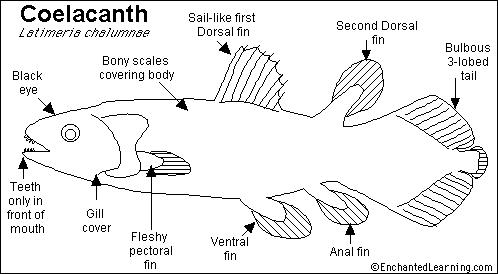
 |
| You might also like: | Dunkleosteus Printout | Sunfish Printout | Swordfish Printout | Dogfish Shark Print-out | Cookiecutter Shark Printout - ZoomSharks.com | Today's featured page: French Language Label Me! Printouts |
| Go to a Coelacanth Quiz More Fish Printouts | EnchantedLearning.com Coelacanth | Animal Printouts Label Me! Printouts |


The coelacanth is an ancestors of vertebrates living on land. It was known by fossils and was thought to have been extinct for millions of years, but a living coelacanth was caught in the Indian Ocean in 1938, near the Comoro Islands (located close to Madagascar, off southeastern Africa). Because of this, people often refer to coelacanths as "living fossils." Other coelacanths have been caught since then. Although the fishermen of Madagascar had known about this fish for years (but had not realized its significance), scientists had no knowledge of it. Modern coelacanths are larger than fossil specimen.
Anatomy: The coelacanth is about 5 feet (1.5 m) long. It has an internal bony skeleton and is covered with silvery-blue bony scales that serve as protection. It has a three-lobed tail, teeth only in the front of the mouth, and a jaw hinged to the skull in a way that lets it open very wide. The name Coelacanth means "hollow spine" (from the Greek, koilos "hollow" + akantha "spine"); it was given this name because the spines on the fins are hollow. The coelacanth is ovoviviparous (it gives birth to live young; the eggs are fertilized internally and remain in the mother's oviduct until birth, the unborn young are nourished with yolk from their egg's yolk sacs, and not a placenta).
Diet: The coelacanth is a carnivore (a meat-eater). It hunts mostly at night (it is nocturnal).
| Search the Enchanted Learning website for: |